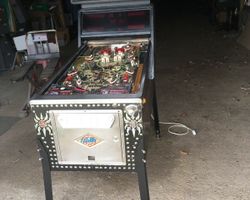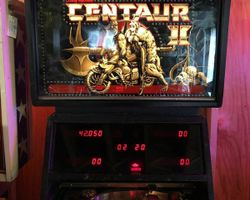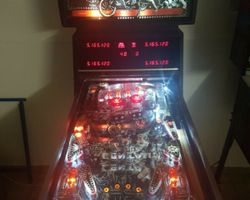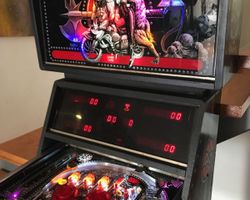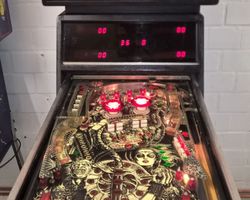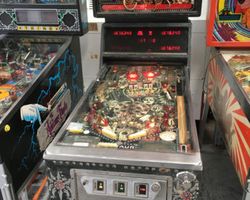Centaur II
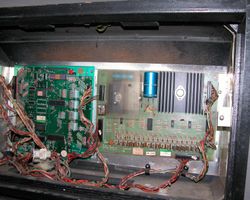
Average Prices: USD $300 to $2,400
Produced: June, 1983
Production Run: 1,550 units
Machine Type: Solid State Electronic
MPU: Bally MPU AS-2518-35
Players: 4
Design by: Jim Patla
Art by: Paul Faris
"Centaur II," a solid-state electronic pinball machine released by Bally Manufacturing Co. in June 1983, emerged as a distinct chapter in the company's output. Designed by Jim Patla, with the evocative artwork of Paul Faris and software by Rehman Merchant, this machine built upon the foundation of its predecessor, the original "Centaur." The theme, a blend of fantasy, monsters, and motorcycles, created a dark, compelling world that set it apart. Production for "Centaur II" was limited to 1,550 units, making it a relatively less common machine. A unique aspect of its creation involved Bally utilizing surplus custom-shaped backboxes left over from their 1982 "Rapid Fire" machine, directly influencing "Centaur II"'s distinctive cabinet profile. This practical decision shaped the machine's aesthetic, adding to its individual character within Bally's portfolio. Jim Patla noted that the inspiration for "Centaur" drew from Bally's 1956 "Balls-A-Poppin'," and Irv Grabel was responsible for engineering the complex multiball mechanism central to the game's appeal.
Signature Features and Design
"Centaur II" commands attention with a striking visual and auditory presence, centered around Paul Faris’s artwork. The playfield and backglass feature a stark, high-contrast palette of black, white, and red, depicting a world populated by menacing figures and robotic steeds. This artistic approach has frequently drawn comparisons to the biomechanical art style, creating a sinister and immersive environment. Beyond the visual, the machine's auditory design distinguishes it. It incorporates both Bally's "Squawk and Talk" speech board and an additional "Say it Again" reverb card. This combination delivers distinct voice prompts and a unique reverberating echo effect that enhances the eerie atmosphere, providing an immersive sound experience that was uncommon at the time.
A primary mechanical innovation is the 5-ball multiball system. This was a sophisticated feature for 1983, demanding a strategic approach to unlock its full potential. The playfield also includes a magnet, positioned beneath a recessed red target in the upper right. When activated, the magnet temporarily holds the ball, adding a dynamic element to playfield interaction. In its attract mode, "Centaur II" features a captivating demonstration: every 15 minutes, all five balls are automatically launched onto the playfield, engaging the pop bumpers and slingshots until they drain. This draws attention to the machine and highlights its frenetic multiball capability even when not actively being played.
Playfield and Mechanics
The playfield of "Centaur II" shares its layout with the original "Centaur," a design choice that ensures a familiar yet challenging experience. The dark, monochrome artwork with strategic red accents continues onto the playfield, creating a cohesive and intense visual experience. The layout is designed for precision and control. Three pop bumpers occupy the upper and mid-right sections, ensuring lively ball movement. Twelve drop targets are strategically placed: two sets of 4-bank drop targets, and a distinct arrangement of four in-line drop targets positioned below the pop bumpers. These "O-R-B-S" targets are integral to activating game features.
Central to the playfield flow are various mechanisms designed to release "orbs" – additional balls that build towards the full 5-ball multiball. These include a chamber feature, accessed by a release target positioned behind a set of inline drop targets, and an upper right release target located above the shooter path. Four blue rollover targets, known as "Guardian rollovers," line the bottom sides of the playfield. Completing three of these triggers a voice prompt announcing, "guardian releases power orb," followed by a ball release. The "O-R-B-S" drop targets, when struck in sequence from left to right, also contribute to ball releases. This multi-faceted approach to ball delivery contributes to the game's depth, requiring players to target different areas of the playfield to advance. The lighting on the playfield is integrated to highlight captured orbs, providing clear visual feedback as players progress towards multiball. The presence of gates on the outlanes offers a chance for skilled players to save a draining ball, adding another layer of strategic depth.
Gameplay Dynamics
"Centaur II" demands precision and offers a progression system centered around its innovative 5-ball multiball. The primary objective is to capture "orbs," represented by amber lights positioned between the flippers. Players work to illuminate these lights by hitting specific targets and activating various release mechanisms, building towards the ultimate goal of launching a maximum of five balls onto the playfield.
Initiating multiball involves several distinct pathways. One method is by hitting the chamber feature, a release target located behind a set of inline drop targets. Another is activating the upper right release target situated above the shooter path. The "Guardian" feature requires players to roll over four blue targets located at the bottom sides of the playfield. Completing these rollovers causes a ball to be released, accompanied by a voice prompt. Perhaps the most iconic method involves the "O-R-B-S" drop targets. When these four white targets, positioned below the pop bumpers, are hit in sequence from left to right, a ball is released. Each successful release adds an "orb" to the collection, increasing the potential for a full 5-ball chaotic multiball.
The scoring system rewards skilled play and strategic target selection. Achieving high scores necessitates mastering the pathways to multiball and maintaining ball control amidst the chaos of multiple balls in play. The gameplay is challenging, requiring precise aiming to hit the various drop target banks and release mechanisms. The game's sound design significantly enhances the gameplay experience, with voice prompts and the distinctive reverb unit providing auditory cues and taunts that reinforce the machine's dark theme. An operator option allows for a two-tilt system, where the first tilt merely displays a "Warning" on the backglass, while a second tilt ends the game, adding a unique risk-reward element to nudge control. After a game concludes, pressing either flipper button initiates a display mode that highlights each major scoring feature on the playfield, with the speech card identifying it by name, offering a post-game review of the machine's mechanics.
Reception and Legacy
"Centaur II" is widely regarded as a significant machine from its era, frequently earning high praise from enthusiasts. Its core strengths lie in its engaging gameplay, distinctive artwork, and innovative sound design. The 5-ball multiball, in particular, stood out as a groundbreaking feature for the time, providing a thrilling and challenging experience that pushed the boundaries of pinball design. The methods to achieve this multiball, requiring precise shots and strategic target completion, are often cited as being ahead of their time, contributing to the game's depth and replayability.
Paul Faris's art package, with its dark, high-contrast aesthetic, is a consistent point of admiration, often described as visually captivating and unique. This artistic direction, combined with the game's innovative sound design—featuring custom speech with a unique reverb and echo effect—created an immersive and memorable atmosphere. The taunts from the machine's "beast" character are frequently highlighted as a standout auditory element. The inclusion of outlane gates for ball saves and the strategic use of a playfield magnet during multiball were also appreciated for adding layers to the gameplay.
Despite its many strengths, the most common point of contention regarding "Centaur II" centers on its custom cabinet design, which was derived from the leftover "Rapid Fire" backboxes. While some found this unusual shape unique and visually appealing, others considered it a less attractive aspect of the machine. Minor criticisms occasionally included the absence of certain playfield elements like a spinner or an outer loop shot, and some players found the machine to be particularly draining, demanding high levels of skill to keep balls in play. Additionally, the compact nature of some internal components was noted by a few as making maintenance more challenging.
Despite these minor points of contention, "Centaur II" maintains a strong reputation. It is often seen as a brilliant machine that offered a more accessible entry point to the gameplay experience of the original "Centaur" due to its distinct cabinet. Its innovative multiball mechanics and complex objectives influenced later pinball designs, solidifying its place as a significant release. "Centaur II" remains a sought-after machine, celebrated for its challenging gameplay, bold artistic vision, and a sound package that helped define a memorable period in pinball history.
Sponsored Links
 Ebay Listings
Ebay Listings
 Auction Results
Auction Results
| Cost | Location | Date |
|---|---|---|
| USD $3,400 |  Massachusetts, United States Massachusetts, United States |
12 May, 2025 |
| USD $3,500 |  Indiana, United States Indiana, United States |
31 July, 2022 |
| GBP £4,200 |  Langport, United Kingdom Langport, United Kingdom |
30 July, 2022 |
| USD $4,000 |  Illinois, United States Illinois, United States |
16 September, 2021 |
| USD $4,000 |  Illinois, United States Illinois, United States |
24 August, 2021 |
| USD $3,000 |  California, United States California, United States |
17 July, 2021 |
| EUR €4,450 |  Nordrhein-Westfalen, Germany Nordrhein-Westfalen, Germany |
24 January, 2021 |
| USD $4,500 |  Wisconsin, United States Wisconsin, United States |
14 January, 2021 |
| USD $2,500 |  New York, United States New York, United States |
09 October, 2020 |
| EUR €2,642 |  Nordrhein-Westfalen, Germany Nordrhein-Westfalen, Germany |
29 February, 2020 |


Private Policy · Search Website · Contact Us
As an eBay Partner, we may earn a commission from qualifying purchases made through links on this site, at no additional cost to you.
All trademarks and copyrighted materials remain property of their respective owners. All other content copyright 2007 - 2025 Pinpedia.

